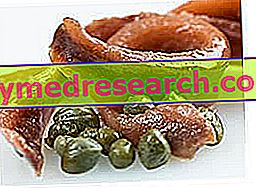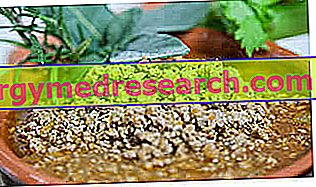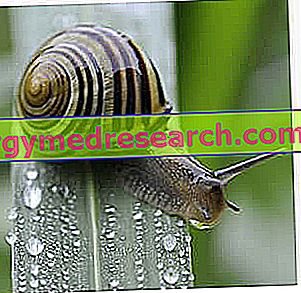Histamine
What is histamine?
Histamine is a nitrogenous compound widely distributed in the body, where it plays a leading role in inflammatory and allergic responses, in gastric secretion and in some brain activities.
In addition to man, histamine can also be produced by other organisms - more or less complex - by simple decarboxylation of the amino acid histidine.

Histamine-rich foods
The concentrations of histamine in foods therefore depend on the richness in free amino acids and on the presence of certain microorganisms.
Poorly preserved fish and histamine
The most characteristic example of histamine-rich food, to the point of triggering problems for those who take it, is that of fish kept too long and / or inopportune manner.
The main offenders in this regard are the specimens belonging to the families:
- Scombridae (tuna, mackerel)
- Clupeidae (sardine, herring, sprat, alaccia, cheppia)
- Engraulidae (anchovy)
- Coryphaenidae (lampuga).
Histamine formation in food
In fish, the formation of histamine is only minimally due to autolytic phenomena, resulting from the death of the animal. Rather, it is due to the proliferation of Gram negative germs that have contaminated the meat.
The bacterial genera most involved are:
- Morganella
- Klebsiella
- Proteus
- Hafnia
- Enterobacter
- Citrobacter
- Vibrio
- Photobacterium.
Other foods rich in histamine
Furthermore, they contain histamine in considerable quantities and are potentially responsible for intoxication:
- Some cheeses
- Red wines
- spinach
- Tomatoes (especially if canned)
- Yeast extract
- Fermented foods, including vegetables like sauerkraut
- Beer.
Hispanic-liberating foods
Other products are called istamino-liberators, because they promote the release of histamine by the body; note how, some of these, are potentially already a vehicle of histamine. Typical examples of istamino-liberating foods are:
- Alcohol
- Bananas
- Chocolate
- eggs
- Fish
- Milk
- Papaya
- Seafood
- strawberries
- Tomatoes.
Thermostable histamine
Once produced, histamine tends to remain unchanged in the food, as it proves to be thermostable, ie particularly resistant to heat.
For complete histamine inactivation a heat treatment of at least 116 ° C is required for 90 minutes.
Histamine intoxication
Foods directly or indirectly rich in histamine, taken in large quantities, can cause symptoms similar to those of a food allergy.
The most common symptoms of histamine excess are:
- itch
- Redness of the face and neck
- Urticaria
- Nausea
- He retched
- Diarrhea
- Headache
- Dizziness.
Depending on the concentration of the substance and individual sensitivity, these symptoms tend to fade quite quickly.
Histamine intolerance
Histamine reactions: intolerance or allergy?
Although the symptomatology of which we have spoken is rather ambiguous and allows to assume an allergic component, the extraordinary reactions to histamine are actually "less dangerous"; in fact, a very important aspect, they do NOT provide for the typical immune activation of these diseases and are therefore among the "food intolerances" (more precisely, from the immunological point of view, we prefer to define them as pseudo-allergic reactions or syndromes).
Histamine intolerance and serious complications
However, in addition to the symptoms described, a very serious clinical picture may occur in cases of greater hypersensitivity. The most severe cases can produce a sharp drop in blood pressure, up to cardio-circulatory collapse or.
Those who are "frankly intolerant" to histamine (about 1% of the general population, more frequently in middle-aged women) and people with primary or secondary failure of enzyme diamin oxidase (DAO - for example taking drugs) are considered at risk. details); in fact, this enzyme participates in the endogenous mechanisms of histamine degradation in the intestine.
Histamine intolerance diet
People with histamine intolerance are prescribed a diet without histamine-rich or histamine-liberating foods ; based on the severity of the symptoms, these restrictions will be more or less important, although generally only the foods listed above are removed, with particular attention to fish, alcohol and all fermented and seasoned foods.
For the speech made previously, the doctor could adjust the dosage of any medications taken or suggest alternatives, while for therapeutic purposes - before the failure of the dietary intervention - could prescribe antihistamine drugs or specific supplements based on diamin oxidase (DAO), vitamin C and vitamin B6.
- Foods particularly rich in histamine : Mackerel - Herring - Sardine - Tuna - Gouda type cheese - Camembert - Cheddar - Emmental - Parmesan - Sausage and canned meat - Salami and sausages - Sauerkraut - Spinach - Aubergine - Tomato - Ketchup - Red wine vinegar - White wine - Alcohol - Fermented beer - Champagne
- Foods able to increase the release of histamine : Papaya - Strawberries - Citrus fruits - Crustaceans - Liquorice - Spices - Pineapple - Egg whites - Dried fruits - Spinach - Chocolate - Spices - Food preservatives such as benzoates (benzoic acid and its salts) - Cranberry
- Foods capable of inhibiting DAO activity : Alcoholic beverages, in particular red wine
Curiosity: Histamine and motion sickness
Did you know that histamine is involved in triggering vomiting in seasickness, motion sickness, airplane sickness, etc.?
Histamine is a neurotransmitter involved in all conditions of motion sickness or "travel sickness".
Histaminergic neurons are stimulated by neurological problems of a vestibular nature (center of balance disturbed by movement sickness) to release histamine, which acts on the vomiting centers (in the brain stem of the brain).
Not surprisingly, part of the antiemetic drugs is constituted by the histamine H1 receptor antagonists located in the brainstem.



